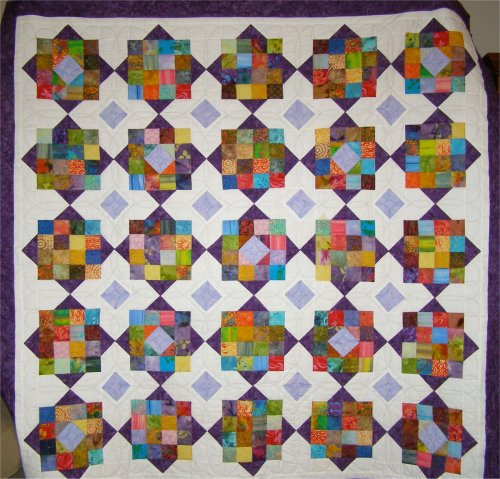To SID or not to SID...that is the question.
Many longarm quilters consider stitch in the ditch to be custom work. It can be very time consuming and hard on your nerves.
Quilters who have never used a longarm don't generally think about how difficult stitch in the ditch (SID) can be. When you compare SID on a domestic sewing machine (DSM) against a longarm, some of the difficulty is not readily visible. I mean, really,
you can't see it! First, on a DSM, your eyes are usually only about 12-15 inches from the needle. And you can easily get your eyes down closer to see details. On a longarm, that distance can jump to 24 inches. And without rolling the quilt, you usually cannot get much closer than 8 inches to the stitching unless you climb on the machine...which is not recommended. My first quilt teacher, Janet Haas, taught that all that mattered when you quilt on a DSM is the "
4 inches around the needle". The longarm has 23 square feet available without advancing the quilt. Size does matter.
Then there is the speed of the needle. A DSM runs about 400 - 1000 stitches per minute while the longarm zooms along at 2400 to 3000 SPM top speed. That doesn't mean that longarmers (LA) always sew that fast. But I have to admit that I can sew a straighter line moving pretty fast rather than crawling along. I think this is true of most quilters, though. Try drawing a straight line with a pencil. If you just move the pencil without thinking about how fast you are going or how straight the line is, you can get a pretty straight line. But when you slow down, your hand jiggles a bit and you get bumps in your straight line. On the longarm, because it is faster than a DSM, if you jiggle, you can put quite a few stitches into the quilt before you stop. Which means you will lose more time to rip out bad stitching. I won't even go into the aches I get when I do a lot of SID. It requires control. My shoulders and elbows must be kept at a certain angle. SID is no place to loosen your shoulders and relax.
The foot can help or hinder you. On a DSM, the
footprint of a walking foot can span an inch or more which can help stabilize the quilt and the stitch. The feed dogs are down but the foot is securely on the quilt. On a longarm, the foot is called a 'hopping foot'. That's because it 'hops'. With each stitch the foot raises and lowers with the needle. This helps with getting over bulky seams. But the
light touch of a hopping foot means that it can be thrown off by seams which have not been pressed consistently. I can be cruising along in the ditch and hit an area when the piecer forgot to press this part of the seam and it's like hitting a bump in the road. Grrrr, I stitched a little bump into the quilt. Now I have to pause and rip out the oops-stitches and re-do the SID, sometimes one slow stitch at a time to make sure the needle goes where I want it to go. It can be grueling work.
So, for me, it is all about the piecing and the
pressing. Even a well pieced quilt top that is not pressed well can be a bear to quilt. When I get a badly pressed quilt top, I make a mental note,
NO SID for this one.






